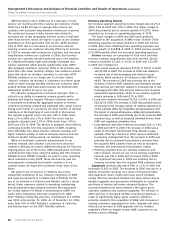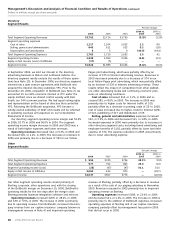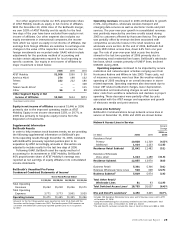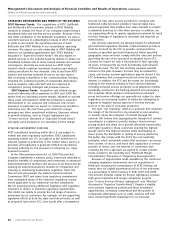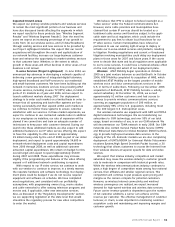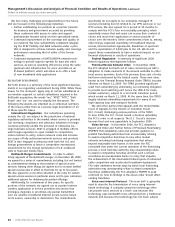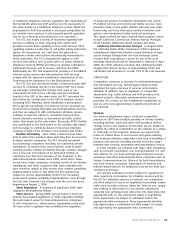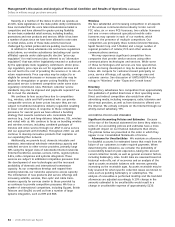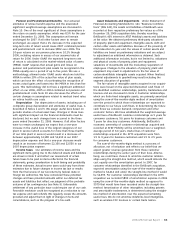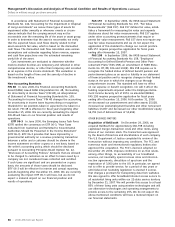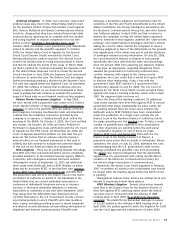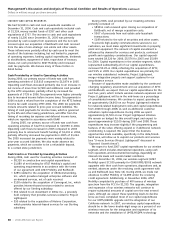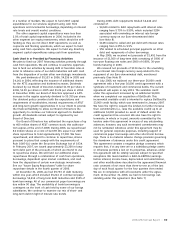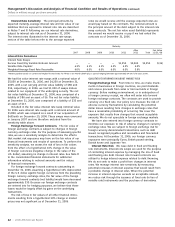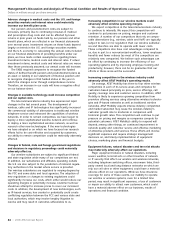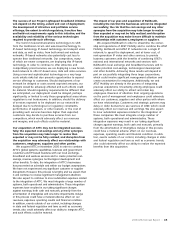AT&T Wireless 2006 Annual Report Download - page 37
Download and view the complete annual report
Please find page 37 of the 2006 AT&T Wireless annual report below. You can navigate through the pages in the report by either clicking on the pages listed below, or by using the keyword search tool below to find specific information within the annual report.
2006 AT&T Annual Report : :
35
Pension and Postretirement Benefits Our actuarial
estimates of retiree benefit expense and the associated
significant weighted-average assumptions are discussed in
Note 10. One of the most significant of these assumptions is
the return on assets assumption, which was 8.5% for the year
ended December 31, 2006. This assumption will remain
unchanged for 2007. If all other factors were to remain
unchanged, we expect that a 1% decrease in the expected
long-term rate of return would cause 2007 combined pension
and postretirement cost to increase $802 over 2006. The
10-year returns on our pension plan were 10.2% through
2006, including returns in excess of our assumed rate of
return for 2006. Under GAAP, the expected long-term rate
of return is calculated on the market-related value of assets
(MRVA). GAAP requires that actual gains and losses on
pension and postretirement plan assets be recognized in the
MRVA equally over a period of up to five years. We use a
methodology, allowed under GAAP, under which we hold the
MRVA to within 20% of the actual fair value of plan assets,
which can have the effect of accelerating the recognition of
excess actual gains and losses into the MRVA in less than five
years. This methodology did not have a significant additional
effect on our 2006, 2005 or 2004 combined net pension and
postretirement costs. Note 10 also discusses the effects of
certain changes in assumptions related to medical trend rates
on retiree health care costs.
Depreciation Our depreciation of assets, including use of
composite group depreciation and estimates of useful lives, is
described in Notes 1 and 5. We assign useful lives based on
periodic studies of actual asset lives. Changes in those lives
with significant impact on the financial statements must be
disclosed, but no such changes have occurred in the three
years ended December 31, 2006. However, if all other factors
were to remain unchanged, we expect that a one-year
increase in the useful lives of the largest categories of our
plant in service (which accounts for more than three-fourths
of our total plant in service) would result in a decrease of
between approximately $2,180 and $2,610 in our 2007
depreciation expense and that a one-year decrease would
result in an increase of between $2,350 and $2,550 in our
2007 depreciation expense.
Income Taxes Our estimates of income taxes and the
significant items giving rise to the deferred assets and liabilities
are shown in Note 9 and reflect our assessment of actual
future taxes to be paid on items reflected in the financial
statements, giving consideration to both timing and probability
of these estimates. Actual income taxes could vary from these
estimates due to future changes in income tax law or results
from the final review of our tax returns by federal, state or
foreign tax authorities. We have considered these potential
changes and have provided amounts within our deferred tax
assets and liabilities that reflect our judgment of the probable
outcome of tax contingencies (see Note 9). Unfavorable
settlement of any particular issue could require use of our cash.
Favorable resolution could be recognized as a reduction to our
tax expense and cash refunds. We regularly review the amounts
provided and adjust them in light of changes in facts and
circumstances, such as the progress of a tax audit.
Asset Valuations and Impairments Under Statement of
Financial Accounting Standards No. 141 “Business Combina-
tions” (FAS 141), the assets and liabilities of BellSouth were
recorded at their respective preliminary fair values as of the
December 29, 2006 acquisition date, thereby recording
BellSouth’s 40% interest in AT&T Mobility’s assets and liabilities
at fair value. We obtained preliminary third-party valuations
of property, plant and equipment, intangible assets, debt and
certain other assets and liabilities. Because of the proximity of
this transaction to year-end, the values of certain assets and
liabilities are based on preliminary valuations and are subject
to adjustment as additional information is obtained. Such
additional information includes, but is not limited to, valuations
and physical counts of property, plant and equipment,
valuations of investments and the involuntary separation of
employees. Changes to the valuation of property, plant and
equipment may result in adjustments to the fair value of
certain identifiable intangible assets acquired. When finalized,
material adjustments to goodwill may result including the
segment allocation of goodwill.
The fair values of intangible assets acquired in our acquisi-
tions were based on the expected discounted cash flows of
the identified customer relationships, patents, tradenames and
licenses and are discussed in Note 2. Customer relationships,
which are finite-lived intangible assets, are primarily amortized
using the sum-of-the-months-digits method of amortization
over the period in which those relationships are expected to
contribute to our future cash flows. In determining the future
cash flows we consider demand, competition and other
economic factors. We have established the weighted-average
useful lives of BellSouth customer relationships as 5 years for
consumer customers, 9.6 years for business customers and
7 years for directory customers. Additionally, BellSouth’s
economic ownership of customer relationships acquired and
recorded at AT&T Mobility will be amortized over a weighted-
average period of 6.4 years. Useful lives of customer
relationships acquired in the ATTC acquisition were from
1.5 to 9 years for business customers and 1.5 to 2.5 years
for consumer customers.
The sum-of-the-months-digits method is a process of
allocation, not of valuation and reflects our belief that we
expect greater revenue generation from these customer
relationships during the earlier years of their lives. Alterna-
tively, we could have chosen to amortize customer relation-
ships using the straight-line method, which would allocate the
cost equally over the amortization period. In 2007, for
customer relationships identified in the BellSouth acquisition,
expected amortization using the sum-of-the-months-digits
method is $4,414 and under the straight-line method it would
be $2,693. For customer relationships identified in the ATTC
acquisition we recorded $899 of amortization expense in 2006
using the sum-of-the-months-digits method as opposed to
$579 that would have been recorded under the straight-line
method. Amortization of other intangibles, including patents
and amortizable tradenames, is determined using the straight-
line method of amortization over the expected remaining
useful lives. We do not amortize indefinite-lived intangibles,
such as wireless FCC licenses or certain trade names.



